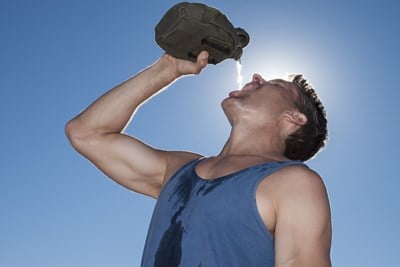Dehydration is the result of excreting more bodily fluids than you’re replacing. It can be anywhere from a mild case of a headache easily remedied with a few extra glasses of water to an extremely dangerous state of imbalance requiring hospitalization and intravenous fluids. Considering its relatively common occurrence and potentially fatal nature, make sure you know the truth amongst the vast amount of misinformation.
Myth: Dehydration is no big deal.
While mild dehydration in a healthy adult can be very easily remedied, the reality is quite the opposite for the very young and very old. If left untreated, symptoms become more and more severe, leaving the body dry, constipated, and feverish, while the mind becomes tired, irritable, and delirious.
Eventually, severe complications can arise: the kidneys may fail, hypovolemic shock (too little blood and oxygen) can occur, and seizures, comas, or heat stroke may set in, depending on the circumstances. Additionally, once the body finally does get fluid, the cells can overcompensate and suck in more water than they can handle, which can cause rupturing. This is especially dangerous for the cells of the brain, which can itself swell, causing cerebral edema.
Myth: You can only get dehydrated when you’re sick.
While it’s much easier to get dehydrated when you’re sick, it can occur at any time, even in healthy adults. Not replenishing enough fluids during exercise or hot weather, forgetting to eat and drink enough on busy days, and not planning ahead for access to clean drinking water on camping or hiking trips can all lead to dehydration.
Additionally, undiagnosed diseases like diabetes can cause excessive urination, which can ultimately cause dehydration, as can diuretics, blood pressure medications, and other medicines that make you sweat or urinate more than normal.
Myth: Thirst is the best indicator of dehydration.
How thirsty you are can be a decent indicator during times of mild dehydration in healthy adults. However, the best way to tell how severe the dehydration has become is by the color of your urine. In well hydrated individuals, the urine is a light, clear yellow. The more dehydrated you become, the darker it turns. Amber-colored urine is a major clue that your body is in desperate need of fluids.
Myth: Drinking anything is better than drinking nothing when you’re dehydrated.
This might be the case if you’re on a deserted island, but in fact, some things can actually make symptoms worse. Drinking clear, sugary liquids like ginger ale to help an upset stomach isn’t going to help much if you’ve been throwing up, because it doesn’t contain enough sodium to replace the electrolytes you’re losing along with fluid. Fruit juice, caffeinated beverages, jello, and milk should be avoided if the dehydration is caused by diarrhea, because they can actually make it worse in children.
Myth: Drinking too much can make you dehydrated.
Although it’s a strange misconception, the root of the fallacy is guessable: the more you drink, the more you pee, so if you drink enough, you start to pee so much you dehydrate yourself. In reality, as long as there aren’t any underlying issues and your kidneys are functioning normally, your body is simply getting rid of the excess fluid. While it is possible to drink too much, the result is quite the opposite. Hyponatremia occurs when the salt in your body is extremely diluted, which messes with the ability of the cells to pass electrical signals. Luckily, it’s relatively rare and completely preventable.



